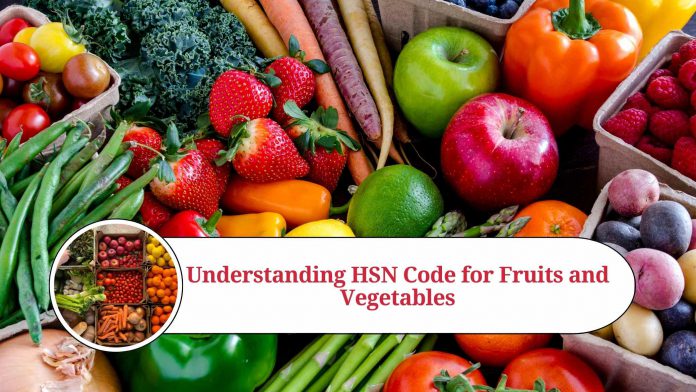The Harmonized System of Nomenclature (HSN) is a global system of classification for goods that is used by customs officials and traders to classify and identify products for the purposes of international trade. It is a standardized system of codes and descriptions that are used to identify different types of products and commodities.
In India, the HSN code for fruits and vegetables is used to classify these goods for the purposes of taxation, and to determine the rate of GST that should be charged on them. Understanding the HSN code for fruits and vegetables is important for anyone who is involved in the sale, purchase, or transportation of these goods.
What is HSN code for Fruits and Vegetables?
The HSN code for fruits and vegetables is 20. This code is used to classify all types of fruits and vegetables, whether fresh or frozen, dried, or preserved. This code is used by customs officials and traders to identify these goods and to determine the rate of GST that should be charged on them.
The HSN code for fruits and vegetables is divided into different sub-categories, based on the type of fruit or vegetable. For example, the code for bananas is 2001, while the code for apples is 2006. These sub-categories allow for more specific classification of these goods, making it easier for customs officials and traders to identify and categorize them.
Why is HSN code important for Fruits and Vegetables?
The HSN code for fruits and vegetables is important for a number of reasons. First, it helps to ensure that these goods are classified and identified correctly for the purposes of taxation. By using the correct HSN code, the appropriate rate of GST can be determined, which helps to ensure that these goods are taxed fairly and accurately.
Second, the HSN code for fruits and vegetables helps to facilitate international trade. By using a standardized system of codes and descriptions, customs officials and traders can easily identify and categorize these goods, making it easier for them to be transported and sold across borders.
Finally, the HSN code for fruits and vegetables is important for consumers. By ensuring that these goods are correctly classified and identified, consumers can be confident that they are getting the products that they are paying for, and that they are being charged the correct amount of tax.
In conclusion
the HSN code for fruits and vegetables is an important system of classification that is used to identify and categorize these goods for the purposes of taxation and international trade. By understanding this system, traders, customs officials, and consumers can ensure that these goods are classified and identified correctly, which helps to facilitate fair and accurate taxation and trade.
Read more useful content:
Frequently Asked Questions (FAQs)
Q: What is the HSN code for fresh fruits and vegetables?
A: The HSN code for fresh fruits and vegetables is 2009.
Q: Are all types of fruits and vegetables classified under the same HSN code?
A: Yes, all types of fruits and vegetables are classified under the same HSN code, which is 20.
Q: What is the purpose of the HSN code for fruits and vegetables?
A: The purpose of the HSN code for fruits and vegetables is to classify and identify these goods for the purposes of taxation and international trade.
Q: How is the rate of GST determined for fruits and vegetables?
A: The rate of GST for fruits and vegetables is determined based on the HSN code that is used to classify these goods.
Q: Are dried fruits and vegetables classified under the same HSN code as fresh ones?
A: Yes, dried fruits and vegetables are classified under the same HSN code as fresh ones, which is 20.
Q: Is there a different HSN code for processed fruits and vegetables?
A: Yes, there are different HSN codes for processed fruits and vegetables, depending on the type of processing that has been done.
Q: What are the sub-categories of the HSN code for fruits and vegetables?
A: The sub-categories of the HSN code for fruits and vegetables include specific codes for different types of fruits and vegetables, such as bananas (2001), apples (2006), and potatoes (2008).
Q: Who uses the HSN code for fruits and vegetables?
A: The HSN code for fruits and vegetables is used by customs officials, traders, and consumers to classify and identify these goods for the purposes of taxation and international trade.
Q: Is the HSN code for fruits and vegetables used in other countries besides India?
A: Yes, the HSN code for fruits and vegetables is a global system of classification that is used by customs officials and traders in many countries around the world.




















